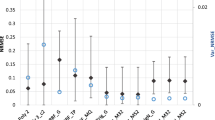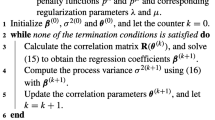Abstract
We propose a new surrogate modeling approach by combining two non-intrusive techniques: Kriging and Stochastic Collocation. The proposed method relies on building a sufficiently accurate Stochastic Collocation model which acts as a basis to construct a Kriging model on the residuals, to combine the accuracy and efficiency of Stochastic Collocation methods in describing stochastic quantities with the flexibility and modeling power of Kriging-based approaches. We investigate and compare performance of the proposed approach with state-of-art techniques over benchmark problems and practical engineering examples on various experimental designs.









Similar content being viewed by others
References
Gorissen D, Couckuyt I, Demeester P, Dhaene T, Crombecq K (2010) A surrogate modeling and adaptive sampling toolbox for computer based design. J Mach Learn Res 11:2051–2055
Jones DR, Schonlau M, Welch WJ (1998) Efficient global optimization of expensive black-box functions. J Global Optim 13(4):455–492
Wang G, Shan S (2007) Review of metamodeling techniques in support of engineering design optimization. J Mech Design 129(4):370–380
Witteveen J, Doostan A, Chantrasmi T, Pecnik R, Iaccarino G (2009) Comparison of stochastic collocation methods for uncertainty quantification of the transonic rae 2822 airfoil. Vrije Universiteit Brussel, Brussels, Belgium, Workshop on Quantification of CFD Uncertainties
Gorissen D, Couckuyt I, Laermans E, Dhaene T (2010) Multiobjective global surrogate modeling, dealing with the 5-percent problem. Eng Comput 26(1):81–98
Ganapathysubramanian B, Zabaras N (2007) Sparse grid collocation schemes for stochastic natural convection problems. J Comput Phys 225(1):652–685
Simpson T, Poplinski J, Koch PN, Allen J (2001) Metamodels for computer-based engineering design: survey and recommendations. Eng Comput 17(2):129–150
Sacks J, Welch WJ, Mitchell T, Wynn HP (1989) Design and analysis of computer experiments. Stat Sci 4(4):409–435
Dwight R, Han Z (2009) Efficient uncertainty quantification using gradient-enhanced kriging. In: Proceedings of the 11th AIAA non-deterministic approaches conference
Ghanem RG, Spanos PD ((1991)) stochastic finite elements: a spectral approach. Springer, New York, Inc., New York, NY, USA
Eldred MS ((2009)) Recent advances in non-intrusive polynomial chaos and stochastic collocation methods for uncertainty analysis and design. In: Proceedings of the 50th AIAA/ASME/ASCE/AHS/ASC Structures, Structural Dynamics, and Materials Conference, AIAA-2009-2274
Agarwal N, Aluru N (2011) Weighted smolyak algorithm for solution of stochastic differential equations on non-uniform probability measures. Int J Numer Methods Eng 85(11):1365–1389
Xing Y, Spina D, Li A, Dhaene T, Bogaerts W (2016) Stochastic collocation for device-level variability analysis in integrated photonics. Photon Res 4(2):93–100
Schöbi R, Sudret B, Wiart J (2015) Polynomial-based Kriging. Int J Uncertain Quantif 5(2):171–193
Clarke SM, Griebsch JH, Simpson TW (2004) Analysis of support vector regression for approximation of complex engineering analyses. J Mech Design 127(6):1077–1087
Han ZH, Görtz S (2012) Hierarchical kriging model for variable-fidelity surrogate modeling. AIAA J 50(9):1885–1896
Han Z, Zimmerman R, Görtz S (2012) Alternative cokriging method for variable-fidelity surrogate modeling. AIAA J 50(5):1205–1210
Wan X, Karniadakis GE (2005) An adaptive multi-element generalized polynomial chaos method for stochastic differential equations. J Comput Phys 209(2):617–642
Wan X, Karniadakis GE (2006) Multi-element generalized polynomial chaos for arbitrary probability measures. SIAM J Sci Comput 28(3):901–928
Witteveen JAS, Iaccarino G (2012) Simplex stochastic collocation with random sampling and extrapolation for nonhypercube probability spaces. SIAM J Sci Comput 34(2):A814–A838
Witteveen JAS, Iaccarino G (2012) Refinement criteria for simplex stochastic collocation with local extremum diminishing robustness. SIAM J Sci Comput 34(3):A1522–A1543
Matre OL, Najm H, Ghanem R, Knio O (2004) Multi-resolution analysis of wiener-type uncertainty propagation schemes. J Comput Phys 197(2):502–531
Matre OPL, Najm HN, Pbay PP, Ghanem RG, Knio OM (2007) Multi\(-\)resolution\(-\)analysis scheme for uncertainty quantification in chemical systems. SIAM J Sci Comput 29(2):864–889
Yang J, Faverjon B, Peters H, Kessissoglou N (2015) Application of polynomial chaos expansion and model order reduction for dynamic analysis of structures with uncertainties. Procedia IUTAM 13:63–70 (dynamical Analysis of Multibody Systems with Design Uncertainties)
Spina D, Ferranti F, Antonini G, Dhaene T, Knockaert L (2014) Efficient variability analysis of electromagnetic systems via polynomial chaos and model order reduction. IEEE Trans Compon Packag Manuf Technol 4(6):1038–1051
Blatman G, Sudret B (2011) Adaptive sparse polynomial chaos expansion based on least angle regression. J Comput Phys 230(6):2345–2367
Peng J, Hampton J, Doostan A (2014) A weighted \({\ell }_{1}\)-minimization approach for sparse polynomial chaos expansions. J Comput Phys 267:92–111
Preston JS, Tasdizen T, Terry CM, Cheung AK, Kirby RM (2008) Using the stochastic collocation method for the uncertainty quantification of drug concentration due to depot shape variability. IEEE Trans Bio-Med Eng 56(3):609–620
Barthelmann V, Novak E, Ritter Klaus (2000) High dimensional polynomial interpolation on sparse grids. Adv Comput Math 12(4):273–288
Gerstner T, Griebel M (2003) Dimension-adaptive tensor-product quadrature. Computing 71(1):65–87
Klimke A (2006) Uncertainty modeling using fuzzy arithmetic and sparse grids. PhD thesis, University Stuttgart, Shaker verleg, Aachen
Ma X, Zabaras N (2009) An adaptive hierarchical sparse grid collocation algorithm for the solution of stochastic differential equations. J Comput Phys 8:3084–3113
Ma X, Zabaras N (2010) An adaptive high-dimensional stochastic model representation technique for the solution of stochastic partial differential equations. J Comput Phys 229(10):3884–3915
Bungartz HJ, Griebel M (2004) Sparse grids. Acta Numerica 13:147–269
Griebel M (1998) Adaptive sparse grid multilevel methods for elliptic pdes based on finite differences. Computing 61(2):151–179
Bilionis I, Zabaras N (2012) Multi-output local gaussian process regression: applications to uncertainty quantification. J Comput Phys 231(17):5718–5746
Xiu D (2009) Fast numerical methods for stochastic computations: a review. Commun Comput Phys 5(2–4):242–272
Marrel A, Iooss B, Dorpe FV, Volkova E (2008) An efficient methodology for modeling complex computer codes with gaussian processes. Comput Stat Data Anal 52(10):4731–4744
Kleijnen JP (2009) Kriging metamodeling in simulation: A review. Eur J Oper Res 192(3):707–716
Sudjianto A, Chen W, Jin R (2002) On sequential sampling for global metamodeling in engineering design
Sasena MJ, Papalambros P, Goovaerts P (2002) Exploration of metamodeling sampling criteria for constrained global optimization. Eng Optim 34:263–278
Zhu Z, Zhang H (2006) Spatial sampling design under the infill asymptotic framework. Environmetrics 17(4):323–337
Stein ML (1999) Interpolation of the spatial data. Springer, New York
Couckuyt I, Dhaene T, Demeester P (2014) oodace toolbox: a flexible object-oriented kriging implementation. J Mach Learn Res 15(1):3183–3186
Couckuyt I, Forrester A, Gorissen D, Turck FD, Dhaene T (2012) Blind kriging: implementation and performance analysis. Adv Eng Softw 49:1–13
Marelli S, Sudret B (2014) UQLab: A Framework for Uncertainty Quantification in MATLAB. ETH-Zürich
Ackley DH (1987) A connectionist machine for genetic hillclimbing. Kluwer Academic Publishers, Norwell
Bäck T ((1996)) Evolutionary algorithms in theory and practice: evolution strategies, evolutionary programming, genetic algorithms. Oxford University Press, USA
Sobol I (2003) Theorems and examples on high dimensional model representation. Reliab Eng Syst Saf 79(2):187–193
Sudret B (2008) Global sensitivity analysis using polynomial chaos expansions. Reliab Eng Syst Saf 93(7):964–979 (bayesian Networks in Dependability)
Molga M, Smutnicki C (2005) Test functions for optimization needs. http://new.zsd.iiar.pwr.wroc.pl/files/docs/functions.pdf
Lee SH, Kwak BM (2006) Response surface augmented moment method for efficient reliability analysis. Struct Saf 28(3):261–272
Loeve M (1977) Probability theory, 4th edn. Springer, New York
Novak E, Ritter K (1999) Simple cubature formulas with high polynomial exactness. Constr Approx 15(4):499–522
Author information
Authors and Affiliations
Corresponding author
Appendix: Smolyak algorithm
Appendix: Smolyak algorithm
The sparse interpolant \(\mathbf {A}_{L,d}\) given by the Smolyak algorithm is [54]
where \(A_{L,d}\) is the weighted sum of d dimensional product rule, the vector \(\mathbf {k}\) is formed by the interpolation level or order used for each variable, here \(|\mathbf {k}| = k_{1} + \cdots + k_{d}\), and L is the maximum level assumed for the sparse grid. In the above expression, the desired interpolant \(A_{L,d}\) is formed by combination of the one-dimensional rules \(U^{k_{i}}\) of order \(k_i\) which sum or total order \(|\mathbf {k}|\) never exceeds the maximum level L.
To form an interpolant \(\mathbf {A}_{L,d}\) in Eq. (17), the total number of points ( \(\mathbf {H}_{L,d}\)) used by the interpolant is given by the following:
where \(\Theta\) denotes the set of points used in the one-dimensional function interpolation. Moreover, by choosing a suitable one-dimensional node scheme, e.g., Chebchev points, the set of collocation points \(\Theta ^{k}\) obtained are nested.
To illustrate the grid construction based on the tensor product and sparse grid, a two-dimensional example is used here. In particular, the Clenshaw–Curtis rule is adopted to choose the node for the interpolation in each dimension: the resulting collocation point is the extrema of the Chebyshev polynomials. The total number of points \((\mathbf {H}_{4,2})\) using a level 4 sparse grid is obtained by Eq. (18). As result, a maximum of 17 nodes are chosen for each dimension and a total of 65 collocation points (Fig. 10b) are required to build the desired SC model. The corresponding tensor product grid is obtained by the product of the 17 nodes chosen in each dimension by the Clenshaw–Curtis rule. As a result, 289 \((17 \times 17)\) points (Fig. 10a) are required to build the desired SC model by a tensor product, which is approximately 4.5 times the total number of points required by the corresponding sparse grid.
Rights and permissions
About this article
Cite this article
Kaintura, A., Spina, D., Couckuyt, I. et al. A Kriging and Stochastic Collocation ensemble for uncertainty quantification in engineering applications. Engineering with Computers 33, 935–949 (2017). https://doi.org/10.1007/s00366-017-0507-0
Received:
Accepted:
Published:
Issue Date:
DOI: https://doi.org/10.1007/s00366-017-0507-0





